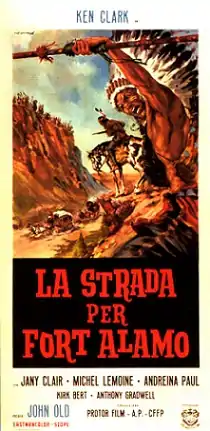| The Road to Fort Alamo | |
|---|---|
 Italian film poster | |
| Directed by | Mario Bava |
| Screenplay by |
|
| Story by | Enzo Gicca Palli[2] |
| Produced by | Achille Piazzi[1] |
| Starring |
|
| Cinematography | Ubaldo Terzano[1] |
| Edited by | Mario Serandrei[1] |
| Music by | Piero Umiliani[1] |
| Color process | Eastmancolor |
Production companies |
|
| Distributed by | Belotti Film[1] |
Release dates |
|
| Countries |
|
| Box office | £173.865 million (Italy)[4] |
The Road to Fort Alamo (Italian: La strada per Fort Alamo) is a 1964 Spaghetti Western film directed by Mario Bava.
Cast
- Ken Clark as Bill Mannerly/"Lieutenant John Smith" (Bud Massidy in the English version)
- Jany Clair as Janet
- Michel Lemoine as Kid Carson
- Andreina Paul as Mrs. Collins
- Alberto Cevenini (as Kirk Bert) as Slim Kincaid/"Private Jim Kincaid"
- Gustavo De Nardo (as Dean Ardow) as Sergeant Warwick (Sergeant Carter)
- Antonio Gradoli (as Anthony Gradwell) as Captain Hull (Captain Hollis)
- Gérard Herter (uncredited) as Mr. Silver
Background and production
The Road to Fort Alamo was produced before the conventions of the Spaghetti Western were established with A Fistful of Dollars.[5] European Westerns had become popular when Germany's Rialto Film bought the rights to Karl May's Western novels, and made several films with director Harald Reinl with his Winnetou series.[1] Some of the films in that series were international co-productions involving Italian funding.[1] As they became more successful in Italy, Italian investors began producing their own Westerns with four produced in 1964: Mario Costa's Buffalo Bill, Hero of the Far West, Sergio Corbucci's Minnesota Clay, Sergio Leone's A Fistful of Dollars and The Road to Fort Alamo.[1]
Mario Bava biographer Tim Lucas described The Road to Fort Alamo as resembling the Winnetou films, as opposed to the style Leone developed with A Fistful of Dollars.[6] The Road to Fort Alamo was filmed at Elios Film Studios in Rome and on location between February and March 1964.[1] Michel Lemoine, who had a supporting role in the film, spoke about his work on it with Bava, stating that Bava "was an extraordinary director and he needed all of his talent to get through [The Road to Fort Alamo], because it was really difficult. The producers had money problems with that picture, and Bava had to fight constantly".[7][8]
Franco Prosperi, who served as one of the film's script writers and Bava's assistant director, expressed distaste towards it, stating that "Mario was useless at making Westerns; he had no talent for it. I disown [The Road to Fort Alamo] completely; it was kind of a disaster."[9]
Release
The Road to Fort Alamo was distributed by Comptoir Français du Film in France on March 24, 1965.[1][3] In that country, it was retitled Arizona Bill in the tradition of the twenty Arizona Bill films made in France between 1907 and 1913, starring Joe Hamman.[1] In the United States, it was released by World Entertainment Corporation on July 10, 1966.[1]
References
- 1 2 3 4 5 6 7 8 9 10 11 12 13 14 Lucas 2013, p. 582.
- ↑ "La strada per Fort Alamo (1964)". Archivio del Cinema Italiano On-Line. Retrieved October 24, 2020.
- 1 2 "The Road to Fort Alamo". Unifrance.org. Retrieved December 15, 2018.
- ↑ "Spaghetti Western Box-Office Stats". Austin Fisher. 9 April 2020. Retrieved June 13, 2020.
- ↑ Lucas 2013, p. 581.
- ↑ Lucas 2013, p. 583.
- ↑ Lucas 2013, p. 585.
- ↑ Lucas 2013, p. 586.
- ↑ Lucas 2013, p. 591.
Sources
- Lucas, Tim (2013). Mario Bava - All the Colors of the Dark. Video Watchdog. ISBN 978-0-9633756-1-2.